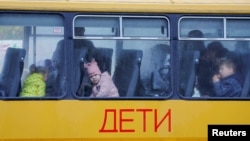When the town of Stepanivka in Ukraine's southern Kherson region was captured by invading Russian forces early in March 2022, the dozens of children at the local orphanage were stranded. At first, orphanage director Volodymyr Sahaydak says, the staff hoped they would be evacuated to Ukrainian-held territory.
"But that hope faded with each passing day," Sahaydak told RFE/RL's Ukrainian Service. "And sometime after about three months, we understood that no one could get us out of the occupation, especially since the Russians were not letting out this category of children in such numbers."
By that time, it was becoming clear that the Russians were taking thousands of Ukrainian children to Russian-occupied Crimea or to Russia.
According to a February 14 report by the Yale University School of Public Health's Humanitarian Research Lab as part of a U.S. State Department-backed human rights project, at least 6,000 Ukrainian children were removed from newly occupied parts of Ukraine after the full-scale invasion on February 24, 2022, "with orphans and those who were residents of state institutions [apparently] targeted for deportation to Russia's territory for adoption and/or placement in foster care."
Such actions, the report added, "could constitute a potential war crime and crime against humanity in some cases."
"We were under occupation," Sahaydak said. "Face-to-face, without financing, without government support, and it was hard. Of course, we understood that our life would be radically different."
The 53 children and teens in Sahaydak's charge, ranging in age from 3 to 18, would have to go underground.
'We Might All Be Taken To Russia'
In the early days of the occupation, civilians fled the area, taking their own families to safety. The orphanage's workers were no exception and soon Sahaydak found himself with just two other staffers.
The occupation authorities imposed a 5 p.m. curfew and public transport stopped running at 3 p.m. Staffers who normally worked until 8 p.m. had to leave for home by 2 p.m., he says.
"All through this time, we led a conspiratorial life," Sahaydak recalled. "The children could not go outside. We had a closed courtyard...that wasn't visible from the street. We'd let the children go out there in small groups for 15-minute stretches. They couldn't shout or laugh or run around. They knew that if there was any noise, we would be discovered."
"They understood that we might all be taken to Russia, so they behaved themselves," he said.
Gradually, Sahaydak and his remaining staff found refuge for the children in the homes of sympathetic families that remained in the occupied areas. Some families took in three or even four of the children, at great risk to themselves.
Sahaydak says he learned how to use Photoshop so that he could forge letters and documents to help the families pass through the numerous occupation-authority checkpoints.
During the summer, the Russians showed up at the orphanage – not to take children away, it turned out, but to bring some for shelter.
"In June the Russians found us," Sahaydak said. "They knew that it was a shelter for children. They had a problem because on the frontline settlement of Novopetrivka, they had found a boarding school where 15 children were sheltering in the basement."
"Russian soldiers brought them to us," he said, recalling that the children arrived on military trucks. "They were scared because they thought they were being taken to Russia."
No Return?
The new children stayed at the orphanage for three months, with the occupation authorities periodically checking on them. Sahaydak didn't dare try to hide them because a search would likely have led to the discovery of the other children as well.
"When [the Russians] began fleeing the Kherson region on October 19, of course they came and took the children," he said. He says the children were taken first to the occupied Ukrainian region of Crimea, and then to the Russian city of Anapa.
After the Russians withdrew from the city of Kherson and other parts of the region, including Stepanivka, Sahaydak's orphanage was finally evacuated to the neighboring Mykolayiv region.
Stepanivka, on the northwestern edge of the city, remains under regular shelling. The orphanage building was damaged by Russian fire on December 11, one month after Ukraine regained control of Kherson, Sahaydak says.
"We can't return to our center," he said, "because Kherson is shelled and shelled every day."










